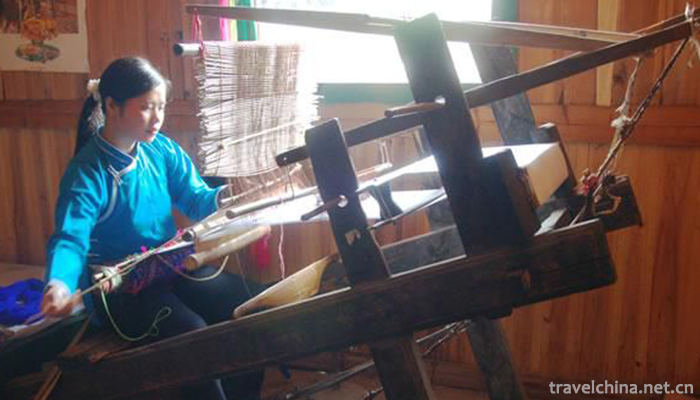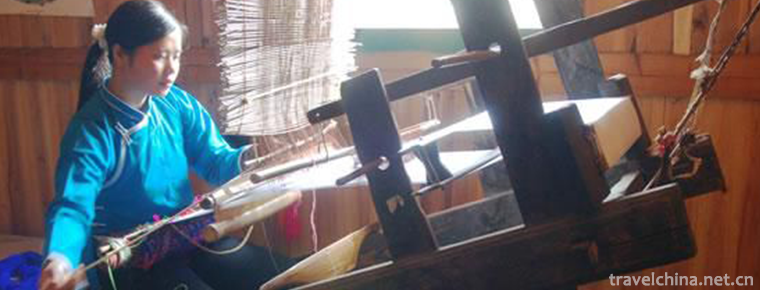Dong Brocade Weaving Techniques
Dong Brocade Weaving Techniques
Dong brocade weaving technology, the traditional handicraft of Tongtong Dong Autonomous County in Hunan Province, is one of the national intangible cultural heritage.
Dong brocade weaving techniques can be traced back to the Spring and Autumn Period and Warring States Period more than two thousand years ago. From the Han Dynasty to the Tang and Song Dynasties, the textile and dyeing techniques of Dong ancestors have formed their own unique style. During the Ming and Qing Dynasties, with the formation of the Dong nationality and the maturation of its traditional culture, Dong brocade weaving techniques have also been greatly developed.
In June 2008, Dong brocade weaving technology was listed in the second batch of national intangible cultural heritage list by the State Council of the People's Republic of China. The item number is_-104.
historical origin
The early days of Dong Jin can be traced back to more than 2000 years ago. According to the records of Guizhou Jingxin Zhi, the ancient Dong nationality "embroidered miscellaneous patterns are like ribbons and knitted flowers are like brocades". Liping Bamboo Branch Ci has the phrase "Songhuo nights together with various female companions, weaving into Dong Jin's official defeat." Liping Fu Zhi contains Zhang Yingzhao as Zhuge Liang, who wrote "Zhuge Jin" in the three years of its construction and when Pingding Nanzhong was built. Back to Taiguchun, Gange is used everywhere, and the eyes are new; Ramie is embroidered with reference to the text, the branches are woven with new flowers, and there are also skillful people in Manxiang.
Li Yanshou of Tang Dynasty has a record of "bureaucrats can cloth fine cloth, and the color is fresh and clean".
By the Tang and Song Dynasties, the textile technology and dyeing technology of Dong ancestors had made great progress, especially in the color matching of textiles and clothing, which had accumulated rich experience and formed their own aesthetic characteristics.
In the Ming and Qing Dynasties, with the formation of the Dong nationality and the maturity of its traditional culture, the Dong brocade also entered a period of prosperity and development.In the Ming Dynasty, Guo Zizhang praised the Dong brocade in Qian Ji.In the Qing Dynasty, the Dong brocade was well-known.In Hu Fengheng's Bamboo Branch Ci of Li Ping in Kangxi Dynasty, there was a praise of "Tong brocade exaggerates the ancient prefecture". In Qianlong Dynasty, Zhang Yingming praised the Dong brocade in more poems: "There are also skillful people in Manxiang's vertebral buns." It can be seen that the Dong brocade was already skilled in ancient times.
Process characteristics
The traditional Dong brocade is divided into "Su brocade" and "Cai brocade". It is called "Su brocade" woven with black and white cotton yarn, and "Cai brocade" woven with black and white yarn and colored yarn. According to different uses, it can be divided into daily brocade, Shou brocade, Fa brocade, etc. Among them, daily brocade can be divided into 12 types, including quilt, blanket, cloth, headband, cover cloth, leg binding, etc. After the death of the old man, the coffin is padded. The brocade rules are specially used as hanging slips and blankets worn by priests in sacrificial rites.
The lines of Dong brocade patterns are straight lines. The common patterns are herringbone, cross-shaped, mouth-shaped, zigzag, rice-shaped, kaleidoscopic, etc. The overall patterns are mostly geometric figures, such as diamond, square, triangle, etc. The Dong brocade patterns are reproduced in a highly decorative form by means of generalization and abstract deformation. The patterns woven by Dong brocade are diverse in subject matter and rich in content, from the cosmic day. Moon and stars, clouds, thunder and lightning, mountains and rivers, to the birds and animals in nature, plants, flowers and fruits, and even the world of human deities.
Technological process
The task of knitting a Dong brocade is very large, usually through more than ten processes, such as cotton rolling, spinning, dyeing, twisting, warp arranging and brocade weaving. The pattern on the Dong brocade is realized by two processes, one is knitting, the other is pick-up. When weaving, the bamboo strips are taken out and moved sequentially, so that the number of pick-up warp is different, the warp lines are separated, and then weft is woven. The number of bamboo sticks used varies according to the complexity of the pattern. Generally, 120 to 180 bamboo sticks are used. According to the density of the brocade, the warps are usually 800, 880, 960, up to 1040.
The difference between picking and weaving technology is that picking does not have bamboo sticks and heddle warping, that is to say, there is no pre-set procedure, the pattern is all in mind, the warp lifting during weft passing is totally remembered by heart, and the warp (i.e. picking), opening and crossing weft are counted with the copper in the weaver's hand.
Inheritance and protection
Inheritance value
Dong brocade has its own unique weaving skills, rich patterns with national characteristics, rich cultural connotations, bright and harmonious colors, elegant and dignified quality and distinct national style. Dong women take brocade as a carrier, displaying their intelligence and exquisite weaving skills, carrying and interpreting the traditional culture with long history and rich connotations of their own nation, and weaving brocades in Ethnic Minorities of China. China has strong local and national characteristics.
Inheritance status
The rapid development of social economy in China's ethnic areas has impacted the traditional and living customs of ethnic minorities by industrial civilization, and the inheritance of the traditional craft of Dong brocade has also been affected. It is urgent to protect the traditional culture of ethnic minorities and the excellent traditional craft of Dong brocade.
Inheriting characters
Sutianmei, female, Dong nationality, born in August 1964, is a member of Fengxiang Village, Yatunpu Town, Tongdao County, Hunan Province. In June 2009, Sutianmei was selected as the representative successor of the third batch of national intangible cultural heritage projects. Tongdong Autonomous County, Hunan Province declared.
protective measures
In 2008, with the support of the government of Tongdao County, Suita Mei founded "Tongdao Xiongguan Dong Brocade Square" in Yatunpu Town. She began to weave Dong Brocade in batches. At the same time, she regularly held Dong Brocade Weaving Training Courses to transfer her Dong Brocade skills unreservedly to villagers in surrounding villages.
social influence
Important exhibition
In October 2008, the Tong Jin Shang Dong Jin Cultural Exhibition was held at Shanghai Donghua University. The representative inheritor of the national intangible cultural heritage project, Suitan Mei, was invited to demonstrate the Dong brocade weaving skills on the spot.
Honorary commendation
In 2008, Suitamei's Dong brocade works won the first prize in the first Dong brocade cultural exhibition in Tongdao County.


-
1.Mount QianQianshan Mountain
Mount Qian,Qianshan Mountain is located 17 kilometers southeast of Anshan City, Liaoning Province, with a total area of 44 square kilometers.
Time 2018-12-04 -
2.Heng Dian World Studios
Hengdian Film and Television City is a large-scale comprehensive tourist area which integrates film and television, tourism, vacation, leisure and sightseeing
Time 2018-12-07 -
3.Funiu Mountain Skiing Resort
Located on the north slope of the old boundary ridge of Funiu Mountain in Luanchuan County, Luoyang Funiu Mountain Skiing Resort has the highest elevation of 2200 meters and an elevation of 1700 meter
Time 2018-12-22 -
4.Kuanguo Museum
The Kuanguo Museum is a special museum built on the site of the Kuanguo Cemetery in the Western Zhou Dynasty, a national key cultural relic protection unit. It covers an area of 100,000 square meters
Time 2019-01-13 -
5.Lushan Karst Cave Group Scenic Area
Yiyuan Karst Cave Group is located in Nanlushan Town, 7 kilometers northwest of Yiyuan County. It has been proved that there are more than 100 caves in the area of 5 square kilometers around the ape-m
Time 2019-02-06 -
6.Muzhaling Luoyang
Located in Checun Town, Songxian County, Luoyang City, Henan Province, Luoyang Muzhaling is a National Nature Reserve of Funiu Mountain and a world geological park.
Time 2019-02-06 -
7.Eight Delicacies in Hot Sauce
Babao chili sauce is a famous traditional dish in Shanghai, with bright color and spicy fragrance. It is improved from fried chili sauce. "Babao chili sauce" tastes hot, fresh and slightly s
Time 2019-03-25 -
8.Exhibit of lanterns
The Lantern Festival is an ancient folk culture in China. It generally refers to the large-scale lighting exhibition held by the government around the Spring Festival and the Lantern Festival
Time 2019-04-26 -
9.Hu Yiyang Legend
Hu Yiyang (about 1639-1718) is a good prime minister. He is a native of Liuting Village, Renhua Township, Moxian County (now Liuting Street, Chengyang District, Qingdao City).
Time 2019-05-03 -
10.Weaving and Dyeing Techniques of Felt and Printed Fabric
Uygur felt, printing and dyeing technology, Xinjiang Uygur Autonomous Region Turpan (now Turpan) local traditional skills, one of the national intangible cultural heritage.
Time 2019-05-04 -
11.Shu Brocade Weaving Techniques
Shu brocade weaving has a long history. The earliest written records were found in the reign of Huiwen King in the Spring and Autumn Period and Qin Dynasty. During the Warring States Period, Shu Broca
Time 2019-06-15 -
12.Bronze Ware Making Skills Datong Copper Ware Making Skills
Datong bronze ware is a traditional handicraft of the Han nationality. It has a long history and exquisite craftsmanship. As early as the Northern Wei Dynasty, it enjoyed a great reputation. Since the
Time 2019-06-21